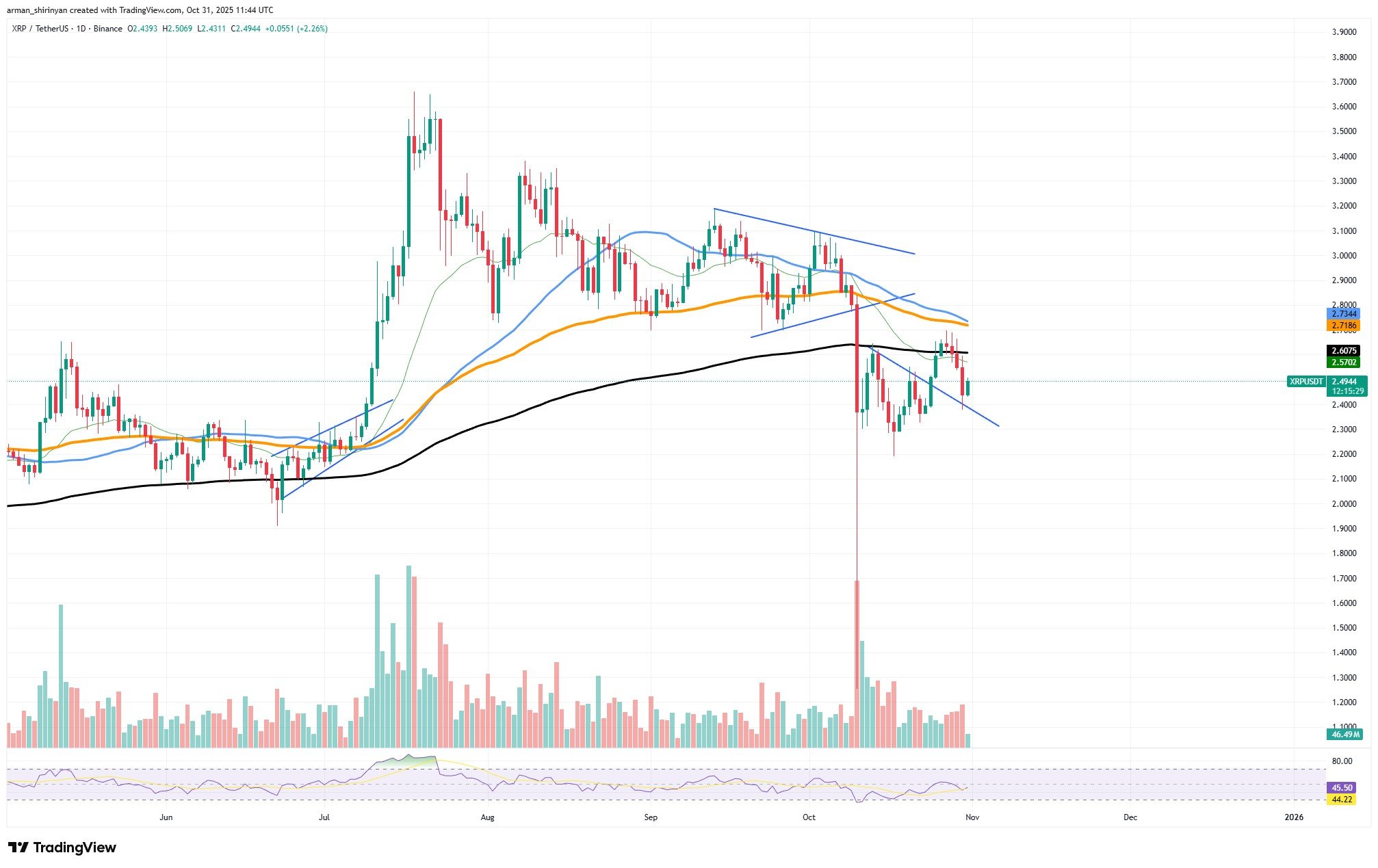XRP’s on-chain activity has declined sharply, with payment volumes dropping nearly 70% from over 700 million daily transactions in early October to around 230 million by month’s end. This signals reduced network utility and bearish sentiment, trading at $2.49 amid technical resistance.
-
XRP payment volume drops 70%: Key indicator of declining network demand and utility in Ripple’s ecosystem.
-
Bearish technicals persist: XRP struggles below 100-day and 200-day moving averages at $2.78 and $2.81.
-
Transaction throughput falls: From 700 million to 230 million daily, raising questions about institutional and remittance adoption.
Discover why XRP’s payment volume drop signals caution for investors in 2025. Explore on-chain data, technical analysis, and recovery outlooks for this major cryptocurrency.
What is Causing the XRP Payment Volume Drop?
XRP payment volume drop stems from a significant reduction in transactional activity on the Ripple network, where daily transfers have plummeted from over 700 million in early October to approximately 230 million by the end of the month. This decline, reported in on-chain metrics from blockchain analytics platforms, reflects lower demand for XRP in cross-border payments and remittances. Factors include market stagnation and a shift away from speculative trading, impacting the token’s overall utility.
How Are Technical Indicators Reflecting XRP’s Bearish Sentiment?
XRP’s current price hovers around $2.49, positioned just above short-term support levels but facing resistance from the 100-day moving average at $2.78 and the 200-day at $2.81. The Relative Strength Index (RSI) sits at 45, indicating neutral but leaning bearish momentum, as the asset failed to sustain a breakout from a descending wedge pattern. On-chain data from sources like Santiment and Glassnode corroborates this, showing a 70% drop in payment volumes that limits upward potential. Experts, such as blockchain analyst Benjamin Cowen, have noted in recent analyses that such metrics often precede prolonged consolidation phases in altcoins like XRP. Short sentences highlight the risks: transaction throughput is slowing, investor confidence is waning, and support at $2.40-$2.35 must hold to avoid deeper corrections toward $2.10.

XRP/USDT Chart by TradingView
The chart above illustrates XRP’s struggle against key moving averages, underscoring the bearish outlook tied to the payment volume drop.
This week’s developments in XRP’s ecosystem reveal broader challenges for the cryptocurrency. As a bridge currency designed for efficient global payments, XRP relies heavily on high transaction volumes to demonstrate value. The recent 70% plunge not only questions immediate adoption rates but also echoes historical patterns where on-chain inactivity correlates with price stagnation. Data from Ripple’s own transparency reports, as cited in industry overviews, shows that peak usage often aligns with bullish market cycles, while downturns like this one suggest a cooling off after earlier hype.
Delving deeper into the metrics, the reduction in transfers between accounts points to diminished organic usage. Institutional players, who drive much of XRP’s volume through partnerships with financial entities, appear to be scaling back amid regulatory uncertainties and macroeconomic pressures. For instance, while Ripple continues to expand its On-Demand Liquidity (ODL) service, real-world implementation has slowed, per reports from financial news outlets like CoinDesk. This isn’t isolated; similar trends have affected other payment-focused tokens, but XRP’s scale amplifies the impact.
From a market perspective, the bearish sentiment is palpable. Traders on platforms like Binance and Kraken have reported lower liquidity, with order books thinning out. The failure to hold above the descending wedge trendline, as observed in TradingView charts, reinforces this view. If selling pressure mounts, the next support zones at $2.35 and $2.10 become critical. Conversely, a push above $2.80 could signal renewed demand, potentially sparking a recovery in on-chain activity. Analysts from firms like Messari emphasize that XRP’s long-term viability hinges on regaining transactional momentum, especially as competitors like Stellar gain ground in remittances.
Looking at historical context, XRP experienced a similar dip in 2022 during the broader crypto winter, where volumes fell over 80% before rebounding with regulatory clarity. Today’s scenario, while concerning, may represent a necessary adjustment following October’s speculative surge. Investors monitoring wallets and exchange flows via tools like Chainalysis data note that whale accumulation has been muted, further dampening optimism. Nonetheless, Ripple’s ongoing legal victories against the SEC provide a foundational strength, even if they haven’t yet translated to volume growth.
Frequently Asked Questions
What Factors Are Driving the XRP On-Chain Activity Decline in 2025?
The XRP on-chain activity decline in 2025 is primarily driven by reduced remittance and institutional usage, leading to a 70% drop in daily transactions from 700 million to 230 million. Market stagnation and bearish technicals, including RSI at 45, contribute to this trend, signaling caution for short-term recovery.
Is XRP’s Payment Volume Drop a Sign of Long-Term Weakness?
No, XRP’s payment volume drop doesn’t necessarily indicate long-term weakness; it reflects a cyclical adjustment after high speculation. With support at $2.40 and potential for breakout above $2.80, renewed adoption in cross-border payments could reverse this, as historical data from Ripple’s ecosystem suggests resilience during consolidations.
Key Takeaways
- XRP Payment Volume Plunge: A 70% reduction in daily transactions highlights immediate network utility concerns and advises monitoring for support breaks.
- Bearish Technical Signals: Trading below key moving averages with neutral RSI points to limited upside without volume resurgence.
- Recovery Path Ahead: Breaking $2.80 could trigger on-chain rebound; investors should prepare for consolidation while tracking Ripple developments.
Conclusion
In summary, the XRP payment volume drop and prevailing bearish sentiment underscore a period of caution for the cryptocurrency in late 2025, with on-chain metrics revealing a stark decline in transactional flow. While technical indicators like the RSI and moving averages reinforce short-term risks, historical patterns and Ripple’s foundational role in payments offer hope for stabilization. As network demand potentially rebounds, staying informed on ecosystem updates will be key—consider diversifying holdings and watching for breakout signals to navigate this phase effectively.
